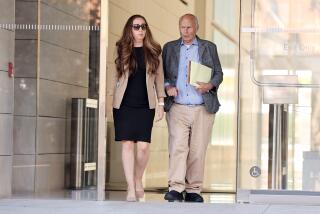Rockefeller impostor murder verdict ‘just,’ prosecutor says
A prosecutor publicly hailed Wednesday’s murder conviction of a man who spent years evading police while pretending to be a member of the Rockefeller family, saying jurors had brought closure in the cold-case killing.
Deputy Dist. Atty. Habib Balian, the lead prosecutor, said the largely circumstantial case had its challenges but that he was relieved jurors resolved the mystery of the killing of John Sohus, who disappeared from his San Marino home in 1985.
Jurors spent about a day deliberating before finding Christian Karl Gerhartsreiter guilty of first-degree murder.
FULL COVERAGE: Rockefeller imposter on trial
Gerhartsreiter lived in a guest house on the Lorain Road property where John Sohus, 27, and his wife, Linda, lived. He was accused of bludgeoning Sohus with a blunt object, burying his body in the backyard and then fleeing to the East Coast, where he lived under a series of false identities, including Clark Rockefeller. Linda has never been located.
“Sometimes, you’re afraid that this guy has conned so many people for so many the years that this will be the one last time that he pulls off his last con,” Balian told reporters after the verdict. “But that didn’t happen and the system worked and the jurors ... came to a just verdict.”
Gerhartsreiter, 52, faces 27 years to life in prison when he is sentenced on June 26.
Much of the trial focused on the audacious frauds that Gerhartsreiter pulled off, claiming he was other people. In San Marino, he introduced himself as British aristocrat Christopher Chichester. In Connecticut, he pretended to be television and film producer Christopher Crowe before convincing some on Wall Street that he was a bond trader.
PHOTOS: Clark Rockefeller investigation
But it was his act as Clark Rockefeller, an eccentric but brilliant member of America’s famous wealthy family, that won him entry to exclusive social clubs and fooled many, including his Harvard-educated wife.
More than 40 witnesses testified during the three-week trial in downtown Los Angeles, recounting stories about the charismatic Gerhartsreiter and the missing couple, who had been married less than a year and a half when they disappeared. John’s remains were discovered in 1994 by a construction crew building a swimming pool for the new owner of the Lorain Road property.
Defense attorneys argued that their client was a simple con man who committed only petty crimes. They pointed out that the prosecution had presented no motive for the killing. The victim’s 29-year-old wife, they said, was more likely to have been responsible for the slaying.
In building a case against Gerhartsreiter, the prosecution had to overcome an array of obstacles. There was no DNA, fingerprints or other forensic evidence identifying the killer. Most of the victim’s remains were mistakenly destroyed in 1995. Witnesses had trouble remembering dates that were nearly 30 years old. The new lead sheriff’s detective had to deal with incomplete reports and missing evidence from previous investigators.
Balian spent roughly three weeks weaving together a case from circumstantial evidence.
The key evidence for the prosecution were two plastic bags from the early 1980s that were found wrapped around the victim’s skull. One was from the bookstore at USC, where Gerhartsreiter attended film classes at the time. The other was from the bookstore at the University of Wisconsin-Milwaukee, where Gerhartsreiter was enrolled from spring 1980 to spring 1981.
The prosecutor argued that Gerhartsreiter slipped up by taking the couple’s new truck with him when he left San Marino. In 1988, he gave the Sohuses’ truck to a friend who tried to obtain its title from California, alerting police that Gerhartsreiter and the missing couple’s vehicle were in Connecticut.
Although Gerhartsreiter had lied about his identity before, he went to more extraordinary lengths to hide who he really was after the killing, particularly when a detective began seeking him in connection with the missing couple, Balian argued. Witnesses testified that Gerhartsreiter changed his address, dyed his hair, used post office boxes and kept his name out of records for the next 20 years.
After Wednesday’s verdict, Balian declined to discuss a possible motive in the case. He said that there was no one piece of crucial evidence but that each piece helped build a picture that showed Gerhartsreiter was responsible.
“The picture that was made was extremely clear,” he said.
ALSO:
Just looking at your phone while driving is now a crime
Loophole may cause release of 86-year-old murder suspect
Puppy tied to train tracks is up for adoption, now named ‘Banjo’
ALSO:
Twitter: @jackfleonard
Twitter: @haileybranson
More to Read
Sign up for Essential California
The most important California stories and recommendations in your inbox every morning.
You may occasionally receive promotional content from the Los Angeles Times.










